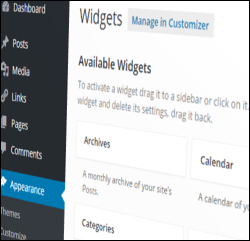 As discussed in this post, there are many benefits in using the WordPress CMS platform to build and grow a web site. One of these is that you can easily add content, enhance your website, or rearrange the layout of your site with no programming skills or knowledge required.
As discussed in this post, there are many benefits in using the WordPress CMS platform to build and grow a web site. One of these is that you can easily add content, enhance your website, or rearrange the layout of your site with no programming skills or knowledge required.
WordPress allows you to quickly and easily insert, delete, and rearrange various types of content on your site’s sidebar menu (and header and footer sections, depending on your theme) using widgets.
Once you know how to use widgets, you can easily add things to your site’s sidebar area (plus headers and footers and other areas, depending on your theme) like:
- list of pages
- content categories
- blog post archive
- menus that display only selected pages
- links to external sites
- posts that you want to promote
- user comments
- advertising banners
- user testimonials
- polls
- content from RSS feeds
- shopping cart forms
- video thumbnails
- twitter feeds
- display widgets from other sites (e.g. affiliate programs)
- administrative forms (e.g. login, register, etc.)

(Widgets make managing and using WordPress easy)
To learn more about what widgets are, how they work and why widgets make managing your site easier, see this article:
In this step-by-step tutorial you will learn how to use and configure a number of frequently-used WordPress widgets.
How To Use Widgets In WordPress
What You Need To Know First
Before we start learning how to configure widgets, it helps to first go over some of the basics about how to use widgets:
Most WordPress Themes Support Widget-Ready Areas
Many WordPress themes support widgets and provide built-in sections in your theme’s layout where you can add widgets, such as the sidebar section, header area, and footer. Depending on your theme, widgets can also display inside the content area …
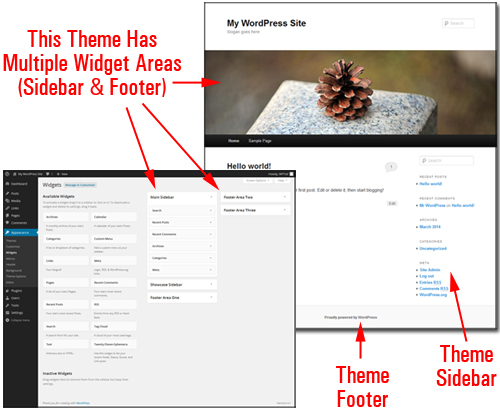
(Many WordPress themes provide multiple widget-enabled sections)
These widget-ready layouts correspond to a feature inside your Widget screen called “Widget Areas” …

(Widget Areas)
Widgets Screen
The Widgets section displays a list of all the widgets that are available.
On the right-hand side of the window, you can see the “active” widgets …

(Widgets can be activated or deactivated by dragging & dropping)
Available widgets can be activated or deactivated by dragging & dropping items to different sections of the screen.
Widgets dragged from the Available Widgets section to widget areas like the sidebar, footer, etc. immediately become available for use on your site.
Your Widgets screen also includes an Inactive Widgets section that lets you remove widgets that you no longer want on your website. Inactive widgets do not lose their settings.
Rearrange Widgets Using Drag And Drop
You can easily add functionality to your site, and activate, deactivate, rearrange and delete widgets by dragging and dropping items inside your Widgets section …

(Rearrange widgets using drag-and-drop)
You can also easily reorder the order and layout of your theme’s widget-ready sections using drag and drop.
For example, take a look at the image below. In this example site, the widgets have already been configured to display things on your site like:
- An opt-in form,
- A contact support button, and
- ’Click to call’ feature from a widgetized plugin (i.e. a plugin that adds an accompanying widget to your site) …
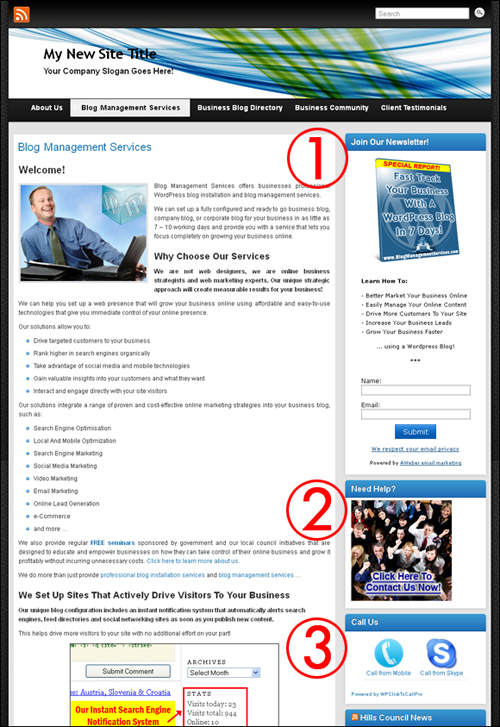
(Widgets control the order certain features on your site display)
If you take a look inside this site’s Widget area, you will see that these features appear on the site in exactly the same order as they have been arranged in the active widget area …

If we reorganize the above widgets in the Sidebar Widget Area by dragging & dropping some of the elements around …
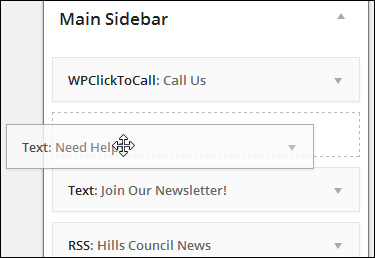
(Drag & drop to rearrange widgets in the widget area)
The widgets have now been reordered in your sidebar …

As you can see, this instantly changes the layout of the site’s sidebar.
Rearranging sidebar layout with widgets can improve your site’s visitor experience.
Note in the screenshot below that the ‘click to call’ feature (3) is now at the top of the sidebar, and the ‘contact us’ graphic button (2) now sits above the newsletter subscription form (1) …
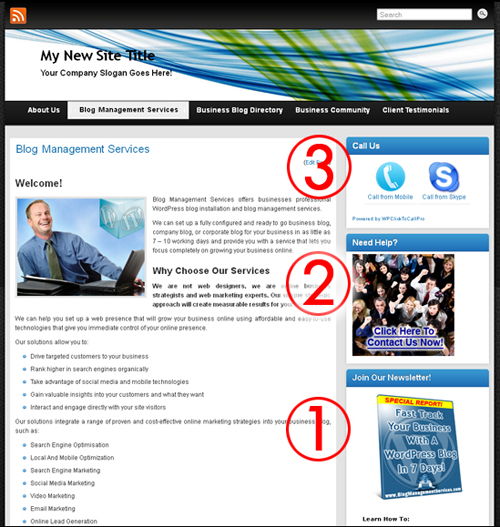
(Rearranging sidebar layout using widgets can improve your site’s visitor experience)
Deleting Widgets From Your Sidebar Menu
Removing widgets from your sidebar menu is very easy.
For example, let’s show you how to remove the Search widget from your sidebar …
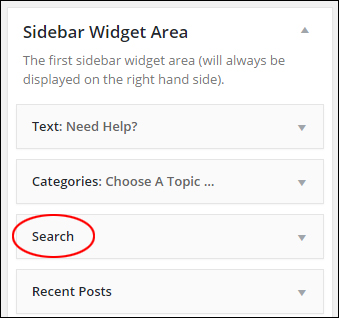
(WordPress Search widget)
To remove an active widget, either open up the widget settings and click the Delete link …

(Deleting a WordPress widget)
Or just drag the widget out of the Active Widgets section and into the Inactive Widgets section …

(Removing a WordPress widget)
Repeat this process for all widgets you want to remove from the sidebar. You can always reactivate a widget by dragging it back into the active widgets area.
Widget Settings
Most widgets can be further customized. This includes making certain types of information hidden to visitors but visible to registered users, displaying additional forms, fields, or information, specifying sizes of sidebar images, videos, etc.
Click on the little triangle in the corner of a widget to toggle between expanding and collapsing the item …
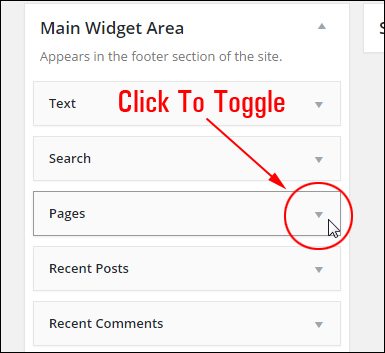
(Toggling expands/collapse widget settings)
When the widget expands, you can change and save your settings, click Delete to remove your widget from the “Active Widgets” section, close the widget, or click on the triangle to collapse the widget settings …

(Widget settings)
![]()
Some widgets may require or offer no customization, or they may only allow you to add an optional title …

(Some widgets offer little to no customizable options)
Widget Customizer Section
Depending on the WordPress theme you are using, you can also customize and manage widgets without making actual changes to your site. This way, you can be sure that you like your customizations before making any permanent changes to your website or blog.
The ability to manage widgets inside the dashboard is a great feature of WordPress. You can work in preview mode inside the WordPress Theme Customizer screen (Appearance > Customize) and see how the widget content will appear before publishing any changes you’ve made (and avoid making errors), or manage widgets on the fly using the Widget editor screen.
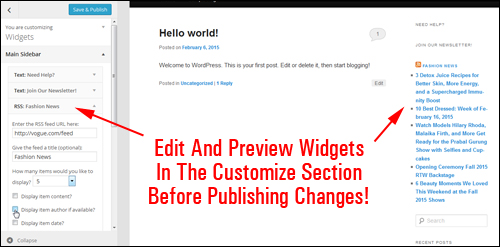
(Edit widgets live in the Customize section)
If you need to make changes to your site while viewing the front-end, just click on the Customize link …

(Customize your site quickly)
This will bring you to the Customizer area in the backend.
You can do several edits, modifications and adjustments to the widgets in preview mode (like adding, removing and moving widgets around), and see all changes in real time. If you like what you’ve done, click the “Save and Publish” button and your changes will then be instantly applied and reflected on the blog’s frontend.
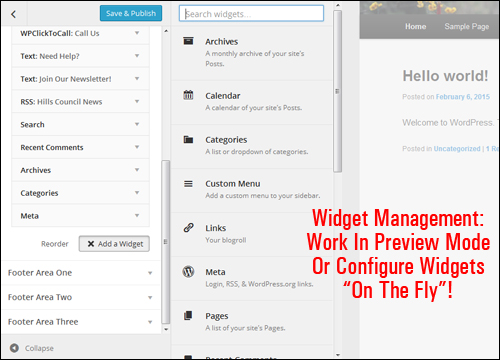
(Widget management – work in preview mode)
After saving your changes, your site will automatically update the widget settings and display the latest configuration to your site visitors.
![]()
Because the theme you choose can affect how elements display on your site, we recommend installing your theme first before configuring widgets.
Also, remember to use the WordPress Customizer to preview your changes. This will save you from having to keep two browsers open while you work through this tutorial.
Now that you know the basics of using widgets, the next step is to begin configuring a number of commonly-used WordPress widgets.
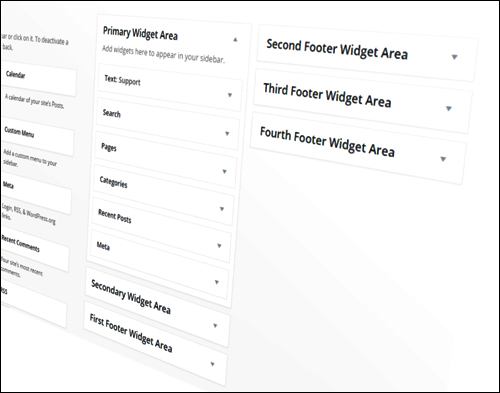
***
This is the end of section one of this tutorial on how to use Widgets.
To view the rest of this tutorial series, click this link:
***
"Your training is the best in the world! It is simple, yet detailed, direct, understandable, memorable, and complete." Andrea Adams, FinancialJourney.org
***